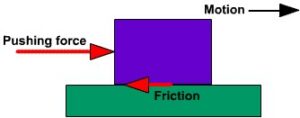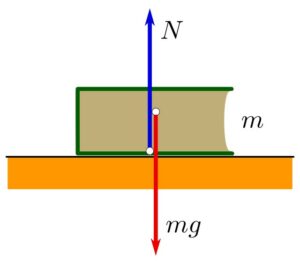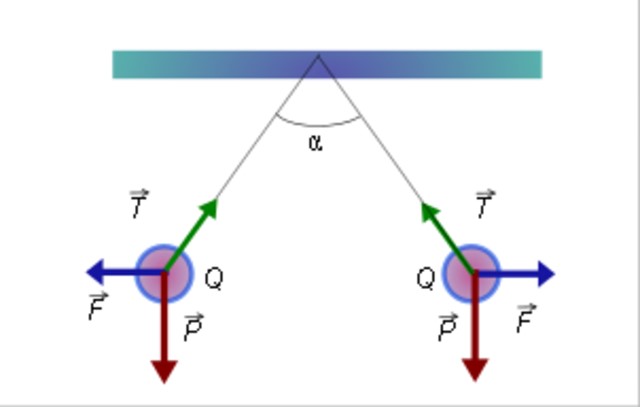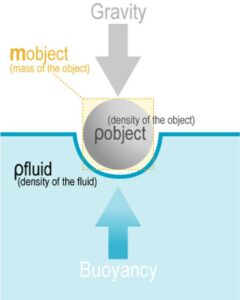External and internal forces are the two basic categories of the forces. External forces are further classified into contact forces and non-contact forces.
As the name itself says, an external force is a force that acts on a system by surrounding. The system needs force to accelerate or to change its kinetic energy, surrounding provides this external force to a system. Let’s discuss the External Forces Examples in detail.
External Forces Examples
Frictional force
When two moving bodies perform motion relative to each other, and the surfaces of these two bodies come in contact, friction occurs. This friction exerts some force on both the bodies and tries to stop their motion or helps them two accelerate.
Friction is a self-adjusting external force, so it adjusts according to the need for motion. Friction is an unbalanced force and is mainly divided into two types.
- Static friction is the friction between surfaces of two bodies when bodies are not moving relative to each other. Static friction mainly depends on the nature of the character and normal force. If the surface is smooth, the static friction is minimum, and rough static friction is maximum.
- Kinetic friction – It is the friction between two bodies when they are in motion. When the external force exceeds the value of static friction body starts to move, and the friction between surface and body decreases; this decreased friction is kinetic. The magnitude of kinetic friction is lesser than static friction.

Normal force
The normal force is the force exerted by the flower on the body standing over that flower. The magnitude of the normal force is equal to the body’s weight, and direction is perpendicular to the surface over which the body is standing. Consider a block of mass M on a horizontal surface, the direction of the normal force is perpendicular to the surface, and the magnitude of the force acting on that block is,

Here, N- normal force on a block
M- Mass of block
g – Acceleration due to gravity of Earth

Tension force
To produce tension in the string, we stretch a string, rope, or cable by two ends. Tension plays a crucial role in pulling heavyweight or hanging the weight at a certain height. Tension is a contact force that transmits through the rope or cable and pulls or holds the object.
When we pull a certain object using rope or cable, we can change the direction of applied force using a pulley, and in this system, the tension in both sides of the string is the same. If a mass is suspended from a ceiling using two ropes and in a stable condition, then in this cause, the tension in the string can be calculated using Lami’s theorem; otherwise, Newton’s second law of motion is used to calculate the tension.

Applied force
It is an external force directly applied to a body by a person or another body. This force is responsible for the acceleration of a body, and this force is non-conservative. Consider a wooden block of mass M on a horizontal surface. A block needs some external force to move from its position, so when we apply force on a block, it starts to accelerate in the direction of the force.
In daily life, we use this force mainly to push or pull things from their position. We can gain a mechanical advantage by using simple machines like lever and axle wheel.

Where, m- mass of an object
a- acceleration of the object
Air resistance
What happens when we drop a feather from a certain height? Why it falls slower than a stone of the same weight? Why can’t it fall straight on the ground? The answer to all of these questions is air resistance or drag. Whenever an object falls from a certain height or moves with a certain velocity, the air applies a resistive force on an object in the opposite direction of motion. his resistive force is called air resistance
Air resistance is also an external force, so it is a non-conservative and dissipative force in nature. The skyscrapers like Burj Khalifa also face air resistance, so to avoid this resistance, structures are built so that the air resistance should be minimum.
To calculate the air resistance following formulae is used,

Where c – force constant
V – velocity of an object

Buoyant force
Have you ever think why we feel lighter in water than on the ground? It happens because water exerts pressure on the body’s surface. As we go deeper in water, the pressure starts to rise. The pressure on the lower part of the submerged body is higher than the upper part, and because of this pressure difference, the body gets pushed towards the water’s surface.
the expression for buoyant force is,

Where ρ- density of fluid
g- acceleration due to gravity
Vf-volume of displaced fluid

FAQ’s
What is internal force?
Forces are divided into internal and external forces on the basis of their interaction with system
The force that acts on the system internally and produces a change in the system or opposes the change in the system by an external force is called internal force. internal forces are produced inside the system, and they can not produce an external change in a system such as acceleration of system or change in kinetic energy of the system.
Why external forces are non-conservative?
The reason behind external forces, also called non-conservative forces, is as follow
External forces depend on the path by which motion of a system occurs, so they do not have potential energy. Similarly, external forces are dissipative, which means, over the period, the system loses energy, so the system’s energy is not conserved. Hence they are also called non-conservative forces.
Is gravity an external force?
The internal and external force is depends upon the system under the study
Gravitational force is the attractive force between two particles of a system. In gravitational force, we study the interaction between two or more particles. Also, the total energy gets conserved in the gravitational force. Hence the gravity is an internal force.
Also Read:
- How to find normal force on a horizontal surface
- Muscular force examples
- Is applied force a contact force
- Is muscular force a contact force
- What is magnitude of force
- How to calculate force of gravity
- Exert force example
- Is friction a conservative force
- Electrostatic force and distance
- What objects have magnetic force
I am Shambhu Patil, a physics enthusiast. I have done M.Sc. in Physics. Physics always intrigues me and makes me think about, how this universe works. I have an interest in nuclear physics, quantum mechanics, and thermodynamics. I am very good at problem-solving and explaining complex physical phenomena in simple language. My articles will walk you through each and every concept in detail.